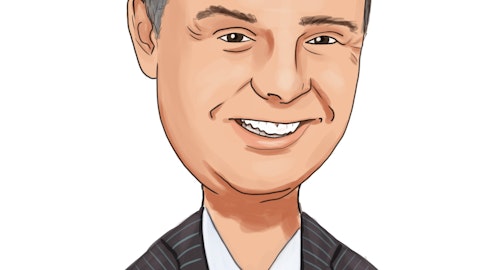Drake Mills: And, Matt, I want to give you a couple of examples. So, we are bringing over new clients, and we’re seeing that loan growth. But two of relationships that I’m very close to: $32 million balance, today, they have a $22 million balance, because they utilized funds on the project; another one, very strong customer of ours, that’s a manufacturer, had — was running $25 million, $26 million. They went ahead and paid off $18 million worth of debt. But we’re still seeing these new — this new client growth as these teams bring them over.
Matt Olney: Maybe a better way to ask kind of a similar question. It sounds like the new producers are kind of building to the team and adding the loan growth. Any change in the utilization rates you’re seeing more recently, if there are some customers paying down some of their debt?
Lance Hall: Well, it’s a little interesting, because we’ve continued to have such good growth, even though we are seeing some of that down, we’ve actually seen a slight uptick in the utilization on the line. We’ve historically averaged like 48%, 48.5% utilization on our revolvers. At the end of the quarter, we were at 51%. Matt, I would just say it this way, like Houston and Dallas do what we thought Houston and Dallas were going to do. I mean we had three of our existing Houston bankers that are dynamic create over $100 million in loan growth last year each for individuals that produced over $1 million in fees. I mean, these markets are just strong growing dynamic, and it’s exactly where we thought it was going to be.
Matt Olney: Okay. And then, going back to the margin, I think the market has growing concerns that the Fed could cut rates later in 2023. If this did happen, I’m curious what your thoughts are what this would mean for Origin? And what are some leverage — what are some options that you consider pulling in 2023, if that was a scenario?
Wally Wallace: Hey, Matt, it’s Wally. We are paying very close attention to the forward curve and are well aware of what the curve is telling us about, what they think the Fed will do. We have spent a considerable amount of time educating ourselves on what opportunities there are to hedge interest rate risk for when and if the Fed starts to take rates down. There are several options that we have in front of us from floors to collars to swaps, we are considering all of the options. Right now, the pricing on hedging instruments is relatively expensive. We watch the curve every day and feel like we’ve educated ourselves enough that we can take advantage of any changes in the curves and any change in the cost to these instruments, and we’ll take advantage of them if they present themselves. So, we are, obviously, asset sensitive, and we’re aware of that, and we will do what we can to begin to position ourselves for when and if the Fed starts to take rates down.
Matt Olney: Okay. Thanks, Wally. And just lastly for me, maybe on credit for Jim. Classified loans pretty flat linked quarter. But obviously, investors are becoming more focused on credit. Would love to hear any updated thoughts that you have, Jim, on the portfolio you’re most focused on, maybe from an industry perspective or geography, kind of what your focus is on maybe overall in the industry, and then maybe specifically within Origin Bank, what you’re most focused on? Thanks.
Jim Crotwell: Good morning. Yes, we — I think what we’re seeing now is the real benefit of the relationships from the — that Lance spoke to the lift-out. I mean these are customers that are well known to our bankers. And so that’s where our growth is. And I think we’re also seeing the benefit of being true to who we are, relationship focused, focused on primary, secondary and tertiary source repayments. When we looked at it and we talked about it before, as we went through the pandemic, and we did deep dives in the sectors, we continue that process. And I’ll just look at office right now, because I know that’s a sector that everybody is really paying close attention to. For our portfolio, it’s very granular. We don’t have any offices that are, say, they’re just downtown business district.
It’s very diversified. One of the things we looked at when we talk about secondary source repayment, the average LTV in that sector for us is about 53%. So that kind of tells you where we are in our underwriting. One other factor, if we go to the tertiary component of that, we have about $385 million in nonowner-occupied office, the combined liquidity of our guarantor supporting those credits is almost exactly the same as $350 million. And if you look at where we are, we have no nonperforming loans and no past dues at all in that sector. And so that kind of gives you an idea. And when you look at the other areas, sectors, if you will, very similar results. And I think that is, again, a manifestation of us being very diligent. And we do not do enterprise value lending.
If we do, it’s going to be very limited. And so that’s consistent throughout. One of the things that we’ve also done is we’ve looked through our portfolio is to go through an exercise from a stress-testing standpoint of evaluating cash flow coverages, if you will, particularly from an interest rate rise perspective. And we’re very pleased with the results, particularly if you take the next step, if you identify credits that maybe have maybe would have some strain from an overall debt service, then you go to what I just spoke to secondary source repayment. And we’re in really good shape there because of being very diligent from a loan-to-value standpoint. We’ve navigated very successfully through various economic cycles, and we feel that we’re very, very well positioned.
As you can see, our level of past dues, which is early indicator. Our level of nonperforming loans is extremely low. And so, I feel really, really good about where we are from an overall portfolio position, given this time of uncertainty. Last thing I would say is that when we look at our markets, we — as I said in the call, we feel really good about our markets that we serve as well, and that they will be less impacted if there is an economic downturn. And from what we’re seeing, hopefully, if there is one, it will be fairly brief and maybe three quarters and we’ll come back out of this very quickly.
Drake Mills: Matt, I’m going to add a little bit to something one of my concerns, and I voiced this through the last several years have been credits that are consumer spending dependent. And we’ve done a tremendous amount of work around understanding those type of stresses in how they would impact if we continue to see a breakdown in consumer spending. And I will tell you, very pleased with what Jim has brought to the table. Preston talks about this. And I’m confident of where we are through ’23. And we’re preparing ourselves for any type of deterioration received. But at this point, and I know it’s going to come to some level, but we’re just not seeing deterioration at this point.
Matt Olney: Okay. Great commentary. Thanks, guys.


